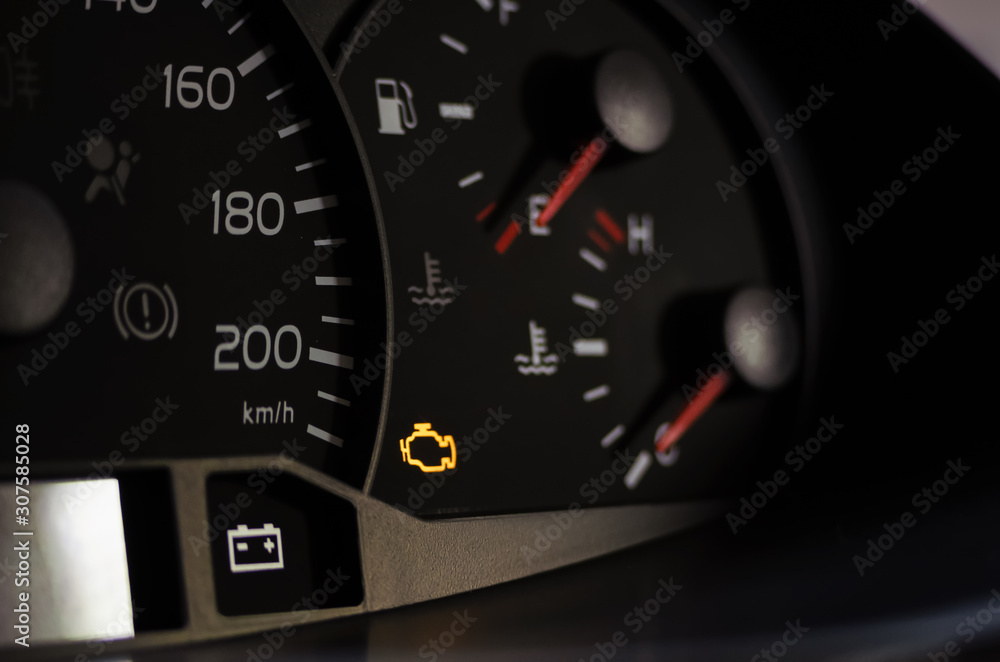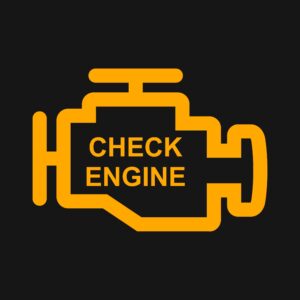How To Check Engine Light Codes Without A Scanner
Having the tools to check your engine codes is very convenient, but not everyone has an OBD2 Scanner sitting around. There are multiple ways to know how to check engine light codes without a scanner.
The most popular way to obtain your car codes is by using your vehicles ignition key.
- First, start by turning the key in the ignition on and off 3-5 times without turning the ignition on. You want to end with your ignition in the on position. If all of the warning lights on your dashboard light up, you can stop turning the key.
- Next, check to see if all of the lights turn off except the service engine light. Newer vehicles tend to have an OBD2 system that shows engine codes on the odometer display. If your vehicle has an OBD1 system, your check engine light will begin to pulse or flash, and the flash created is your fault code.
- The last step is writing down the codes that are displayed. You can find all of the codes to your vehicle in your repair manual to determine what issues are causing your check engine lights.
Another way to check your codes is by using your odometer reset.
- You first want to press and hold the odometer reset button and the trip button at the same time.
- While holding those down, turn the ignition on and release the odometer reset and trip buttons.
- After taking these steps, the diagnostic codes should appear in your odometer display. Again, you can find the codes for your vehicle in the repair manual.
Taking your vehicle to a professional.
Although there are ways to check your codes without a scanner, the best thing to do is to take it to your local mechanic, repair shop or car dealership to identify your check engine light code so you can have it properly repaired. Places such as AutoZone offer free diagnostic scans, they take less than a minute and you’ll get a descriptive report printed and emailed.
What Does My Check Engine Light Mean?
The check engine light indicates that the vehicle’s computer has recognized a fault that needs to be repaired. This is one of the most Common Questions About Cars.
There are a few different meanings to your check engine light depending on what it looks like. If your light is a solid yellow or orange, it means your diagnostic system has detected a problem that needs attention. Yellow/orange lights mean that the problem isn’t detrimental and can wait a few days before it needs to be fixed. You should never drive more than 100 miles before getting your vehicle looked at.
If your engine light is a solid red, it means the issue needs to be fixed soon but your vehicle is able to be driven to your nearest mechanic, repair shop or car dealership to be serviced. A flashing engine light means that the problem is severe and could potentially cause your engine to misfire or fail. No matter what it shows, if your check engine light comes on, its essential to get it looked at as soon as possible.
Common reasons for the check engine light to come on.
- Emission system issues. Problems with the oxygen sensor, catalytic converter, or evaporative emissions system.
- Engine misfires. Issues with ignition components or Fuel Delivery.
- Faulty sensors. Malfunctioning sensors like the Mass Airflow Sensor or Throttle Position Sensor.
- Fuel system problems. Fuel leaks, a loose gas cap, or low fuel pressure.
- Exhaust system issues. Leaks or damage to the exhaust system.
- Transmission problems. Issues with the transmission can trigger the light.
Another reason your check engine light has come on, is if you need an oil change. Oil Changes are essential to keep your engine healthy and running properly.
Risks Of Driving with A Check Engine Light On
Driving with a check engine light on can pose several safety risks, as well as potential risks to your vehicle and the environment.
- Reduced Engine Performance. The check engine light typically illuminates when the vehicle’s onboard computer (ECU) detects a problem with the engine or emission control systems. Ignoring this warning can lead to reduced engine performance, which can affect your ability to accelerate, maintain speed, and respond to traffic situations.
- Potential Stalling. Some engine problems can lead to stalling or sudden loss of power. This can be especially dangerous when driving at high speeds or in heavy traffic, as it may result in a loss of control over the vehicle.
- Emission Control Issues. Many check engine light warnings are related to emissions control systems. Ignoring these warnings can result in increased emissions, which contribute to air pollution and harm the environment. Additionally, some states have strict emissions testing requirements, and driving with a check engine light on may lead to a failed inspection.
- Impaired Safety Systems. Some modern vehicles rely on data from various sensors, including those tied to the engine, to operate safety systems like traction control, stability control, and anti-lock brakes. Ignoring a check engine light may affect the proper functioning of these safety systems, potentially increasing the risk of accidents.
- Potential for Costly Repairs. Delaying necessary repairs can lead to more extensive damage and more costly repairs in the long run. What may start as a relatively minor issue can escalate into a major engine problem if left unaddressed.
To ensure your safety and the reliability of your vehicle, it’s advisable to address the cause of the check engine light as soon as possible.

How To Reset A Check Engine Light Without A Scanner
Resetting a check engine light without a scanner is possible in some cases. It’s important to note that doing so will not fix the underlying issue causing the light to come on. Resetting the light without diagnosing and addressing the problem may lead to more significant issues down the line, and it may also prevent you from passing emissions tests or inspections. If your check engine light is on, it’s best to identify and address the root cause of the problem.
Method 1.
One method of resetting your check engine light is to disconnect the battery. Be sure to have the proper tools and safety equipment before disconnecting the battery. The first step in this process is to be sure the ignition is off and the key is removed from the switch. Using a wrench or socket set, disconnect the negative terminal of the battery, remove the cable from the post and secure it away from the battery to prevent reconnection. After disconnecting, wait about 15 minutes for the vehicles capacitors to discharge, which in turn, resets the check engine light.
After you reconnect the negative terminal to the battery, start your car to see if the light is still on. If the problem that triggered the light has been fixed the light should stay off, but if the problem is still there the light will likely come back on.
Method 2.
Another method of resetting your engine light is to cycle the engine. By turning the engine off several times in a row, you may be able to get the warning light to turn off. When doing this, you want to turn the ignition on and off several times in a row.
Method 3.
There is also the option of pulling the fuse for the engine control unit. This method only tends to work on older cars and it may cause it to reset completely, wiping out all codes. Finding the fuse takes a short amount of time as long as you look in your service manual to find where it is located.
Method 4.
One of the easiest ways to turn off the engine light is by checking your gas cap. Sometimes a loose gas cap can be the reason your check engine light is on. If this is the reason, the system should recognize that its been fixed and turn off the light.
Before resetting your engine light, you want to be sure to Understand The Fine Print Of Your Warranty. Taking something into your own hands could potentially void your warranty and take away all of the benefits that come with it. Visiting a qualified mechanic or automotive technician who can diagnose the issue and perform any necessary repairs is the best course of action while under warranty. Remember that the check engine light is a valuable safety feature designed to alert you to potential problems and ignoring it can have serious consequences.






